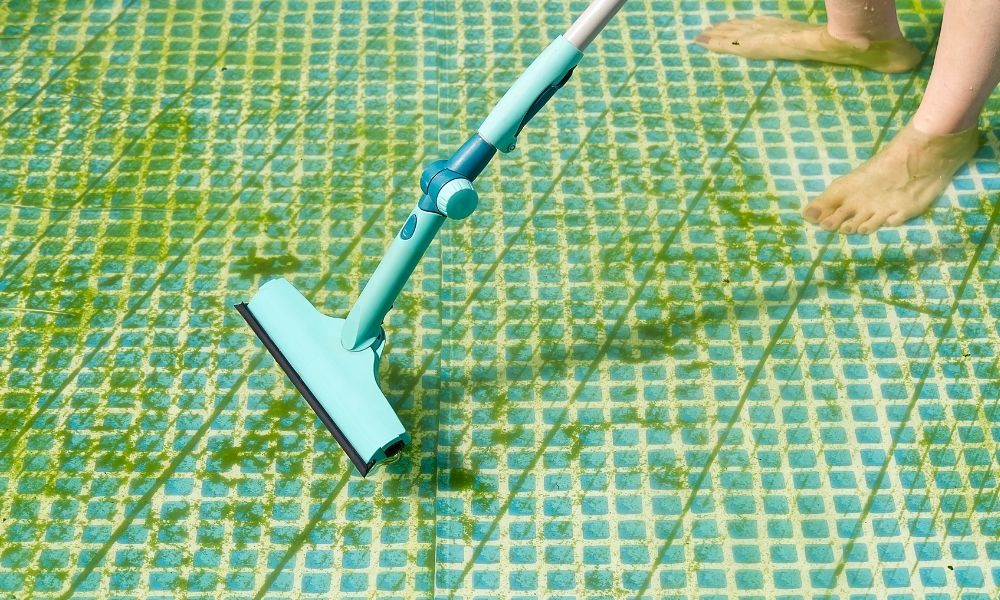
Why Is My Pool Green
Why is my pool green? That’s the question many pool owners ask themselves; therefore, we created this guide to help you solve this problem.
If you have any questions about your pool, then you are in the right place. JB Pool Plastering Corp. is here to help you. Before listing the tips of this post, we want to tell you that there’s only one reason why your pool water is turning dark green: pool algae.
Algae is a living organism that can appear in your pool and as a result of clogged filters and pool water circulation.
Just like pool algae can cause your pool’s water to have a murky look or count on black spots, it can also make it have a green appearance.
Green is a lovely color for grass or leaves, but it is not so lovely when it comes to your pool water’s color. That is why you need to understand what is causing this problem and how to solve it quickly.
Why Is My Pool Green? Avoid It by Following These Tips

When it comes to swimming pools, you always need to avoid green water. The best defense is a good offense; in other words, if you want to prevent all these problems, then give regular maintenance to your pool. But if you are already facing algae, follow our easy steps and get rid of green pool water.
Why is my pool green? There are several reasons why algae appear, such as low water circulation, balance, sanitation, and filtration. Once you identify the reasons that are generating the algae, you must learn how to get rid of this problem.
Remember that if it is a light shade of green, the algae has probably started to take hold.
Now that we have mentioned the common factors why algae appear, we will explain how to prevent them. Then we will focus on listing some tips that will help you clean your pool water when it turns green.
Algae Appear When There Is Low Water Circulation

How do algae blooms occur?
Low water circulation is one of the main reasons why algae grow.
As long as your swim pool water flows, you will not have algae problems because it still needs moisture to grow. We recommend running the filter and testing the water regularly to verify if it flows consistently through the swimming pool.
Make Sure Your Water Is Balanced to Avoid Algae

When was the last time you tested the water balance of your pool?
There are four things that you need to check when testing your water balance. Focus on the pH level, alkalinity, cyanuric, and calcium levels. You can not let the time pass without giving proper maintenance to your pool, or the algae will appear, and the water will turn green.
Be careful with the pH value as a high level indicates that water has greater alkalinity. When these values are coupled with low chlorine levels, it could cause algae growth.
The Chlorine Levels Must Be Consistent

Keeping your water clean is the key to enjoying your pool safely. If you want to avoid expensive solutions, then just follow our advice. We will try to keep it simple for you.
Pay attention to the chlorine level of your pool, as it is the biggest reason why algae grow. All swimming pools are chlorinated, but they need to be balanced.
If the chlorine level is low, the algae will overgrow in the pool. We recommend you buy a test kit to inspect the water regularly, so you will be able to identify if there’s a problem with the liquid chlorine level.
Make Sure the Filters Are Functioning Properly

If you want to prevent algae from growing in your pool, then check the filter pressure. You can not avoid this task as the algae will clog up the filters, and the water will not flow. If you notice that dead algae have begun to accumulate on the surface, let the water circulate for at least 24 hours.
Now that you know which are the best ways to prevent this problem, we will teach you how to take care of algae if it grows in your swimming pool.
Learn How to Fix a Green Pool in Three Steps

There are three basic steps that you need to follow to clean your pool correctly. You will understand how to shock, level, and maintain your swimming pool. You need to focus on raising the chlorine and keep it that way until it eliminates the algae. Follow these three tips and get rid of algae:
Make Sure to Vacuum Your Pool Manually
Most homeowners choose automated cleaners to keep the algae out as it saves time. We recommend those robotic tools for regular pool maintenance but not for deep cleaning.
If you want to get rid of algae, you must vacuum your pool manually to clean the affected areas directly.
Brush the Pool to Remove the Algae from the Walls
It is not enough to vacuum the swimming pool. Once you finish that step, you must brush the walls as the algae might end up settling on them.
Before adding the sanitizer, you need to make sure that you scrub it off the walls properly so that the mix will penetrate deeply. It is recommended to use a pool brush as you can use it to clean the walls and the floor of the pool.
To finish the process, make sure you clean all the corners and other shaded areas of the pool. As an extra tip, we advise you to get your water tested at least once per month during the summer.
Apply a Shock Treatment and Get Rid of the Problem
If you already vacuum and brush your pool and algae persist, then you need to consider applying a shock treatment to get rid of the problem.
In other words, if the infection is heavier, then use a hypochlorite pool shock as it will clean the surface. Read the package instructions to determine the amount of shock you need to apply. It will all depend on the size of the pool.
Why is my pool green? Now that you have read our post, you are ready to answer that question. In this guide, you’ve learned to identify the reasons why your swimming pool turns light green. Not only that, but you also are ready to fix that problem on your own.
If you follow each step of the guide and the problem persists, then give us a call. JB Pool Plastering Corp is here to solve your problems.




